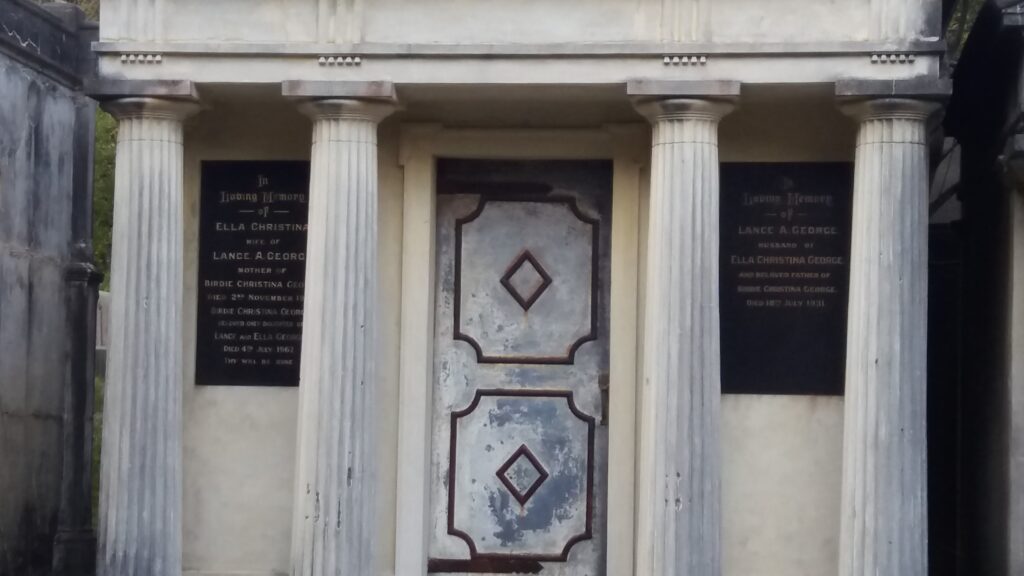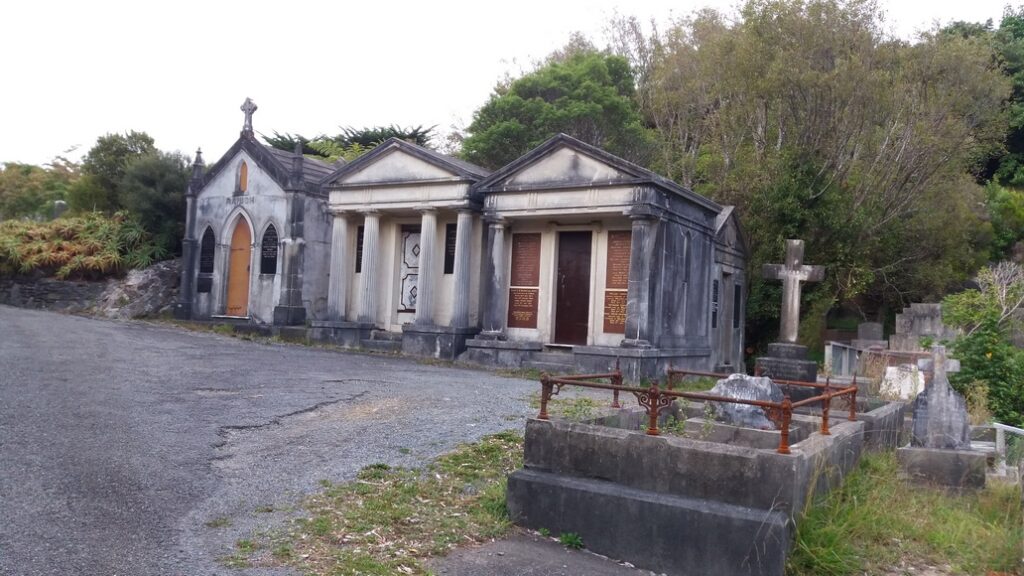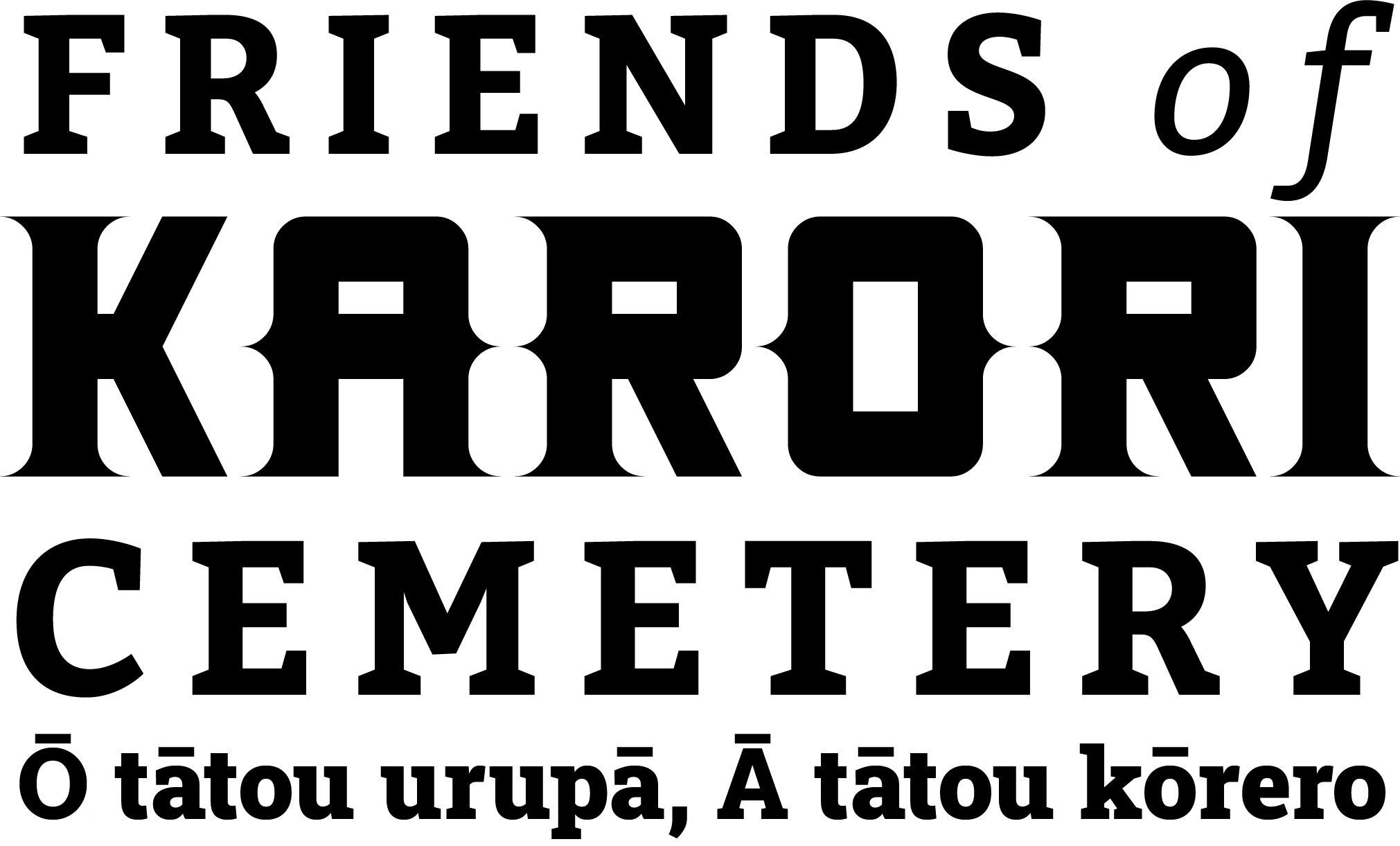A Facebook post on 23 March 2020 showed a detail from the door of one of the “Three Vaults” in Karori Cemetery.

There is a wayfinding place on the “main” road through the cemetery (none of the roads have actual names) which is known to cemetery workers as the “the three vaults”. The reason for this is obvious – there are indeed three family vaults, side by side, facing the road. They stand out amongst the surrounding burial plots which are mostly low to the ground.
The Ranish vault (on the left) is constructed in the Gothic Revival style, a style that would be recognised by many in Wellington’s Parliamentary Library. Gothic Revival was a widespread architectural style in the 18th and 19th centuries and became a rival to classical architecture. The Ranish vault has features typical of this style. On the front elevation is a central pointed arch door, pair of pointed arch niches with memorial tablets and what is presumed was once a pointed arch window over the door. The corners of the vault are expressed as towers, capped with pinnacle ornaments. The roof gable is surmounted by a Celtic cross which emphasises the verticality of the design and which is a key feature of this style.
The George and Jupp vaults to the right are both near-identical Classical revival structures. A good example of this style of architecture in Wellington is Old Government Buildings. Classicism has five Orders, or styles, each with distinguishing features.
Both the George and Jupp vaults rest on a plinth, with columns, a frieze with four Triglyphs (vertical grooves) supporting a pediment. The difference between the two vaults is the number and style of columns.
The middle vault (George) has four Greek Doric columns which are identifiable by the fluting (shallow vertical grooves) on the column shaft. The capital at the top of the columns is also Greek Doric style.
The end vault (Jupp) has only two columns. These columns are plain in the Tuscan style and are complete with a Tuscan capital. It is unusual however to mix the Orders and for the Jupp’s Tuscan style vault to have Doric Triglyphs on its pediment is inconsistent. Either liberties were taken by the masons trying to adapt a temple form of architecture to a more modest setting, or someone had a change of mind on the design mid construction.
The vaults were constructed in late 1922/early 1923 (Ranish), late 1929/early 1930 (George) and sometime after purchase of the plot in August 1930 and the first interment in 1937 (Jupp).
There is a fourth vault, at right angles behind the George & Jupp vaults and not visible unbless approaching the site from down the road, in which various members of the Plimmer family are interred.
RANISH FAMILY VAULT
Henry (known as Harry) RANISH was a billiard table, billiard dining-table, and billiard cushion maker, 110 Lambton Quay, Wellington. There was an extensive item about Harry’s business in the Cyclopedia of New Zealand (Wellington Provincial District) in 1897, which has been digitised as part of the NZ Electronic Text Collection at http://nzetc.victoria.ac.nz/tm/scholarly/tei-Cyc01Cycl-t1-body-d4-d45-d15.html
Ernest Henry (Harry) Ranish was apparently born in Austria in 1864. In 1890 he married Betty BONTY in Melbourne, Victoria, and 3 years later they settled in Wellington, New Zealand, presumably starting their billiard business at that time. Betty died after a long illness in June 1901, and was buried in the Catholic section of Karori Cemetery. Interestingly her headstone was “Erected by her friend Mary Fernandos”.
One year later, in June 1902 Harry married NZ born Beatrice Mary Louise YUILE, and in January 1903 they had their only child, a son they named Ernest Edward Columbus Ranish.
In October 1906 Harry “purchased” a 3,000-acre sheep farm in the Martinborough area from a Mr James Wall. According to newspaper reports of the time, they agreed to do a swap of Mr Wall’s farm for Harry’s billiard business and Wellington properties. It was said that Harry had become unhappy with the labour movement and what he saw as restrictions on his business. The number of reports in the papers of the times in which men who had worked for the company had sued him for underpayment or loss of wages, as well as Harry failing to declare the full cost of imported materials which resulted in the Customs Department taking him to court may have contributed to his decision.
Whatever the reason, Harry went on to become a very successful sheep farmer, until he retired and moved back to Wellington, to live at 88 Freyberg Street, where he died on 10 April 1922, after a long illness. The plot for the vault was purchased in July 1922 and it was built by H Glover, Monumental Mason. Cemetery records indicate Harry was “buried” on 15 February 1923, so he must have either been embalmed and held somewhere or buried after his death and exhumed for placement in the vault some months later.
The other occupants of the vault are his wife, Beatrice, who died in 1953, and his son and daughter-in-law, who died in 1986 and 1982 respectively.
Finally, there are a couple of mysteries – who was Archie JEROME, whose cremated remains were deposited in the vault in 1964; and who was Beatrice Edna MARENDING, died 24 December 1976, who is commemorated on an additional plaque on the left side of the vault?

GEORGE FAMILY VAULT
Very little is known about the George family. However, an obituary in the Evening Post on 20 July 1931 provides some background:
MR. LANCE GEORGE
A private message received. from London yesterday states that Mr. Lance George, formerly of George and George, drapers, Wellington, died in London after a serious operation. The late Mr. Lance George, who was very well known in Wellington, left in March of last year on an extended tour of South Africa and Europe. He was a son of the late Mr. A. George, of South Australia, and brother of the late Mr. A(rthur) A(ndrew) George, who died in Wellington only a few months ago. The two brothers started a drapery business in Cuba street about thirty years ago, and branches were subsequently opened in Petone and Wellington South. The late Mr. Lance George was for a time connected with the Winter Show and the Competitions Society. He took an interest in golf, and in various branches of sport, and was popular with all who knew him in business and private life. His wife predeceased him a year ago last October. His daughter, Miss Birdie George, accompanied him on his world tour. Miss Annie George and Miss Florence George, of Hataitai, are sisters.
When Ella Christina died on 2nd November 1929 the family lived at 130 George Street (at the bottom of Crieff Street). The plot for the vault was purchased on 20 November. Ella was interred in the vault on 20 February 1930, three months after her death. Lancelot was interred on 4 October 1931, only two months after his death in London. Birdie died in 1967, aged 74. They are the only occupants of the vault.
There is nothing on the vault to identify who constructed it.

JUPP FAMILY VAULT
“OBITUARY (Evening Post, 10 February 1937)
MR. W. J. JUPP New Zealand’s oldest band conductor Mr. William James Jupp died at his residence in Willis Street yesterday afternoon, in his seventy-fifth year. Until his health began to fail about three months ago, Mr. Jupp conducted the band which has borne his name for nearly fifty years, and is the oldest band in the Dominion. Outside his wide circle of musical friends, the late Mr. Jupp was known also as the head of a family which has been associated with the growth of Wellington from its early days. The late Mr. Jupp was born in Tunbridge Wells and came to New Zealand in 1874 by the Carnatic, which arrived at Picton. He crossed to Wellington, where he has lived ever since, except for a short time in his youth when he served on one of the coastal boats trading between Wellington and Wanganui. After that he worked for a Mr. Barlow, a greengrocer, and a Mr. Beavis, a pork butcher, both of Willis Street. Later, he started at his trade as a wood turner with Mr. Howler, whose factory was in Clyde Quay. After serving his apprenticeship he began his own business in Victoria Place in 1882. He then moved to Ghuznee Street, where he remained for a short period before moving to the present site in Willis Street, where he has been for fifty years. Mr. Jupp started his career of brass band work at the age of 18, being in George Gray’s Band until they disbanded. In 1889 he formed his own band, which has been in existence ever since as Jupp’s Band. During the Great War the band went over to the Patriotic Society and did yeoman service. The band has always been at the service of the public for any charitable purpose. It has attended several band contests during its career, and has achieved several successes. Two years ago it became the Legion of Frontiersmen’s Band. Mr. Jupp excelled as a cornet player, although, of course, he was a skilful player of any brass instrument. He took lessons from Levy, the world champion cornet player, who toured New Zealand many years ago, and was a personal friend of von de Meden, the great German artist on the same instrument. Hundreds of bandsmen throughout New Zealand received their early training in Jupp’s Band, one of the better known now being Mr. [Dick] Estall, conductor of the Woolston Band. Jupp’s Band will now have for its conductor Mr. H. S. Jupp, who with his brother, Mr. W. G. Jupp, has been playing in it for about 45 years. Besides having been a valued member of the executive of the Brass Bands’ Association, the late Mr. Jupp was a member of St. Andrew’s Freemason’s Lodge. Married in Wellington to Miss L. C. Stephens, of Portsmouth, the late Mr. Jupp in 1932 celebrated his golden wedding, and at the same time his eldest son, Mr. H. S. Jupp, celebrated his silver wedding. About thirteen years ago Mr. Jupp retired from active business. The late Mr. Jupp leaves a widow and a family of three sons, Messrs. H. S. Jupp, W. G. Jupp, and C. T. Jupp, all of Wellington, and six grandchildren, Mrs. K. Duff, Miss K. Jupp, Mr. W. J. Jupp, Miss H. Jupp, Mr. W. C. T. Jupp, and Mr. C. T. Jupp.”
William & Louisa had three sons:
Harry Stephen (1882-1962) married Ada Matilda STEPHENS in 1907. Harry was cremated at Karori.
They had three children: Kyra (married Lionel Ralph Sceats), Zena, Edward
William George (1884-1975) married Mary McInnes in 1911. William’s ashes were interred in the vault.
They had two children: William James, Hazel
Claud Thomas (1885-1972) married Mary Murphy in 1908. Claud & Mary were both buried in the Lawn section at Karori.
They had three children: Claud, Mona, William
William James Jupp purchased the plot for the vault in 1930 and was interred therein two days after his death. Presumably the vault had already been built and was waiting for it’s first occupant. His wife Louisa was interred on 23 Feb 1944, aged 80.
William & Louisa are both interred in the vault, along with the cremated remains of their son William and his wife Mary, and of their daughter-in-law Ada. A great grandson, Warren Lionel SCEATS, was also interred in the vault, in 2003.
Plaques on either side of the door commemorate many other of William & Louisa’s descendants:
Harry (oldest son) – cremated at Karori but no ashes interment in the vault recorded;
William James (grandson) and his wife Kathleen Edith; cremated at Karori but no ashes interment in the vault recorded;
Hazel COLEMAN (granddaughter)
Kyra (granddaughter) and her husband Lionel Ralph SCEATS*
There is nothing on the vault to identify who constructed it.
*Lionel Sceats was Director General of the NZ Broadcasting Corporation for many years.
by Barbara Mulligan
